TechRadar Verdict
A versatile and well-built cameraphone but slightly down on features compared with rivals
Pros
- +
Solid build
Cons
- -
Basic set of features
Why you can trust TechRadar
There's a lot of talk about interactive technology, but the truth is most mobile phones and cameras are simply tools. You pick them up, choose your subject, alter some settings and take a photo - perhaps relying on the device to decide on stuff like focus and exposure. Rarely will a camera tell you what's worth shooting or encourage you to try new approaches.
The Nokia 5500 isn't quite that advanced, but it is home to some genuinely interactive systems to help you train, race or simply get fit. It's also one of the toughest phones around. Most handsets are largely made from moulded plastic - which keeps the weight down but isn't so hot for taking out in typical British weather.
The 5500, on the other hand, has a stainless steel chassis that's shockproof, dust resistant and, most importantly, splashproof. It's not suitable for total immersion in water but can resist the sweatiest gym session.
Despite its rugged specification, the 5500 is pleasantly rounded to hold and portable at just over 100g. The square 208x208-pixel display is small but sharp and Nokia's menu system is as easy to use as ever.
The new addition to the Nokia is a movement sensor that, once you've entered your height, weight and typical heart-rates, can work out speed, distance covered and calories burned in a range of sports (walking, running, cycling and rowing).
It's simple to switch between phone, sports and music mode by hitting a swap key on the right side of the phone. In sports mode, the Nokia will read out your performance statistics if you give the keypad a firm tap. It's handy but a little quiet unless you're wearing the stereo hands-free kit.
The 2Mp onboard camera is accessed through the menu (or a home screen shortcut). The square format screen doesn't help with framing, reducing its effective size to around an inch. Try to ignore the size limitations and you'll notice how crisp and responsive the LCD is - it's nearly as good as some camera screens.
Features are basic. There's a 4x digital zoom and Night mode to help with lowlight shots, but no flash or LED for really dark scenes. A burst mode stutters its way to six full-quality shots over about ten seconds, although it's difficult to work out exactly when the shutter will fire. You can choose from a few preset white balances and colour effects, and select image quality and size.
Images look much better once transferred to a computer than they do on the cramped screen. There's lots of wide-angle barrel distortion and colour fringing but there's also plenty of detail to be found, even given the meagre 2Mp maximum resolution. Exposure is lively and colours (especially skin tones) are punchy and pleasing, although the white balancing can be erratic.
Sound quality for voice calls and MP3 playback is very good indeed - and you can even choose music with a tempo to match your exercise. Overall, this is an extremely fit phone, making up in toughness and ease of use what it lacks in raw photo ability.
Tech.co.uk was the former name of TechRadar.com. Its staff were at the forefront of the digital publishing revolution, and spearheaded the move to bring consumer technology journalism to its natural home – online. Many of the current TechRadar staff started life a Tech.co.uk staff writer, covering everything from the emerging smartphone market to the evolving market of personal computers. Think of it as the building blocks of the TechRadar you love today.
